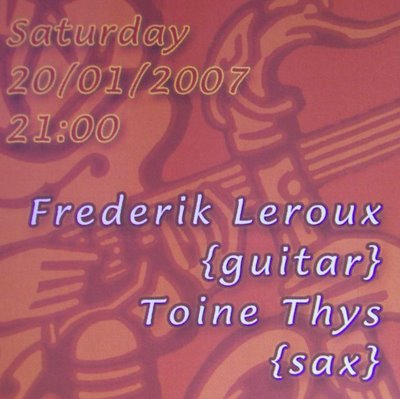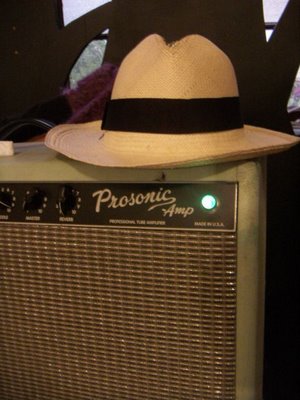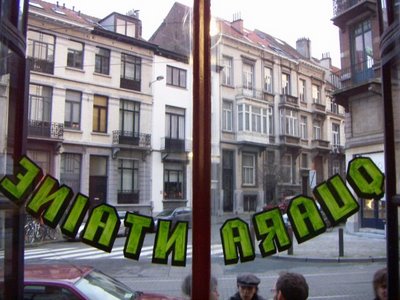 Kurt Van Herck Trio
Kurt Van Herck Trio
Van Herck is a near-ubiquitous saxophone player, with the Brussels Jazz Orchestra for instance, but he rarely leads his own groups. His last album came out 10 years ago. His new album (which, coincidentally, was waiting for me when I got home) is in trio with guitarist Jacques Pirotton and drummer Mimi Verderame, playing the unrecorded compositions of Karl Van Deun, a barely known guitarist. It's almost the Herbie Nichols Project, on a Belgian scale (and Van Deun is alive and well). The sparsely populated tent wasn't exactly the best environment for this music, what with kids running around, people moving in and out, a basketball tournament outside, etc. Still, what I managed to hear (I got there late) was unexpectedly good, but I'll listen to the CD before discussing it further.
 The Bad Plus
The Bad PlusI had high hopes - very high hopes - for this one, which were easily surpassed. If anyone invites a blow-by-blow review, it's TBP, so I apologise in advance for what's to come.
The concert was insane, as in insanely good, but also as in "TBP is crazy!" On the left, you had Ethan Iverson, generally cool as ice behind the piano or dead-panning these incredible spoken introductions that must be at least partly improvised or embellished, because even his bandmates were laughing. The intro to "1980 World Champion" was particularly good, involving Lyle Mays (not
Lyle Mays), a ski jumping world champion from Ann Arbor, Michigan, who celebrated his title every day by dancing in the street. On the right, you had Dave King, whose body movements have to be seen to be believed. I guess he has a reputation as a banger, but he's actually more likely to be making a subtle kind of clatter. And then, in the middle you had Reid Anderson, the dapper bassist. What they do as a group is even more impressive live than on record: you can really see how they fit bits of improv into the the manic arrangements' interstices. And, of course, there's the random stuff thrown out apparently just to keep people guessing, such as the brief groovy soul bass solo that served as coda King's "Thrift Store Jewelery," totally unrelated to the modest melody and Latin undertow of the body of the song.
They played a lot of new, unrecorded songs. Ethan's concert-opening "Mint" continually seemed to have two things going on at once, and juxtaposed a dozen more, starting with some great abstract piano blues. Reid is an awesome composer, whose pieces tend to have a rock song feel to them. The first encore, "Physical Cities," was the biggest and best of them: it switched between ascending piano arpeggios over a hard-driving riff and a stabbing hip hop groove. The downshift from the stomping latter to the low-lying former was particularly delicious. And then, out of nowhere, came this unison morse code staccato section, with lots of dramatic rests. Imagine the rhythm of a Tim Berne composition, played on one note. It might have lasted 90 seconds, but what was so thrilling about it was that I truly had no idea how long it would go on, or what would come next (which happened to be a massive beat based on the morse code).
"Casa Particular," another unrecorded tune, surprised - shocked, even - by staying in one engrossingly low-key place throughout: King pushed forward relentlessly, but on brushes and very quietly (I was reminded of Jorge Rossy on the version of "Exit Music (For A Film)" on Mehldau's
Art of the Trio: vol. 4), while the piano drifted and dreamt prettily. "1980 World Champion," like "1972 Bronze Medallist" before it, set up big, simple chords and then sprinkled them with dissonance. Here, though, it was done over a fast 2-beat that, when King picked up a tambourine and Ethan played some blues, lent the song a fervent gospel feel.

Of course, TBP is loved and hated for their covers (even though I generally find their originals more rewarding). Their versions of Interpol's "Narc" and Bacharach's "This Guy's In Love With You" had some common ground: sweeping crescendos leading to a big chorus, for example. The Bacharach was the more sarcastic one: a subdued 12/8 led to
faux cocktail piano; sleigh bells comically accented a break. Ornette Coleman's "Song X" (I don't have that album, must get it) started with the melody played in trio unison three times, with yawning chasms of silence in between. This led to fast Ornette-ish swing, open and rambunctious, and the most traditionally-configured piano solo + rhythm section passage of the concert. What happened next was, therefore, totally unexpected. Reid subverted the song twice: first by playing a slow and relatively melodic solo, then, as he stuck ultra-quietly and minimally to a couple of high-register notes, King rubbed a whining, blinking toy on his floor tom. Deploying near-silence against a somewhat talkative crowd was bold and brilliant. Well, it all seemed subsersive to me, and on a tune by the
nec plus ultra in jazz subversiveness, no less!
Finally, the second encore (concerts in the tent usually struggle to get one encore, so it's a tribute to TBP that they could easily have gotten a third, if the organisers hadn't wrapped it up) was "Chariots Of Fire," as requested by an audience member. Some people don't like this cover, but I think the superposition of the theme, played at varying tempos, and an unrelated funky bass line really works. Also, the way it opens up into a scrambling free section reminds me of my all-time favourite TBP cover, Blondie's "Heart Of Glass" on
These Are The Vistas. Here, Ethan started the song standing stock-still, staring unblinkingly out into space and playing a few notes with his hand behind his back. Those theatrical touches are fantastic and really help them communicate with the audience. Both times Ethan named the band members, they'd play fragments of a theme music: silly, but great fun.
Afterwards, we had a jazzblogger tripartite summit (not quite Yalta, but almost?) with Ethan and
Jazzques at the Archiduc, laughing and discussing everything from Brad Mehldau to hip hop to blogging to TBP itself to writing/reading about music to the virtues and advantages of the siesta and many other things I'm forgetting. Reid and sound man/engineer/designer Michael (I think) joined us later. Excellent times. One interesting thing I hadn't really realised was the extent to which Ethan is a jazz kid. Do The Math hints at that, but I'd always assumed he started out from a classical and contemporary music background, but not at all. On a personal note, there was absolutely none of the awkwardness you usually get around visiting musicians, who are, essentially, people you've never met before. Maybe it's Ethan's sense of midwest hospitality or something.







































